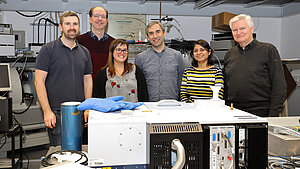In nature, energetically uphill reactions such as ATP synthesis and energetically downhill reactions such as NADH oxidation by oxygen are coupled indirectly through the use of electrochemical gradients. Increasingly, the concept of electron bifurcation has come to prominence as an alternative biological energy conservation mechanism, and there is a need to understand its function in detail.
The [FeFe] hydrogenase from the hyperthermophilic bacterium Thermotoga maritima (HydABC) is known to couple the energetically uphill oxidation of NADH to NAD+ to the energetically downhill oxidation of ferredoxin to generate hydrogen. Although there are already a few hypotheses, how these reactions are coupled remains enigmatic and it is essential to understand this important and interesting phenomenon.
In a new study published last week in the <link https: link.springer.com journal _blank>Journal of Biological Inorganic Chemistry by scientists of the MPI CEC and <link https: www.global.hokudai.ac.jp _blank>Hokkaido University, Japan, TmHydABC was produced with high yield and purity, permitting the detailed spectroscopic and functional characterization of this electron-bifurcating enzyme. Their results favor a novel mechanism for electron bifurcation, facilitated by the specific arrangement of iron-sulfur clusters. Furthermore, the efficient enzyme production method described in this work will allow further sample intensive studies in order to garner additional insight into the elusive mechanism of electron bifurcation in this and related enzymes.
Chongdar, N., Pawlak, K., Rüdiger, O., Reijerse, E.J., Rodríguez-Maciá, P., Lubitz, W., Birrell, J.A., Ogata, H. (2019). Spectroscopic and biochemical insight into an electron-bifurcating [FeFe] hydrogenase. Journal of Biological Inorganic Chemistry. <link https: doi.org s00775-019-01747-1>doi.org/10.1007/s00775-019-01747-1

